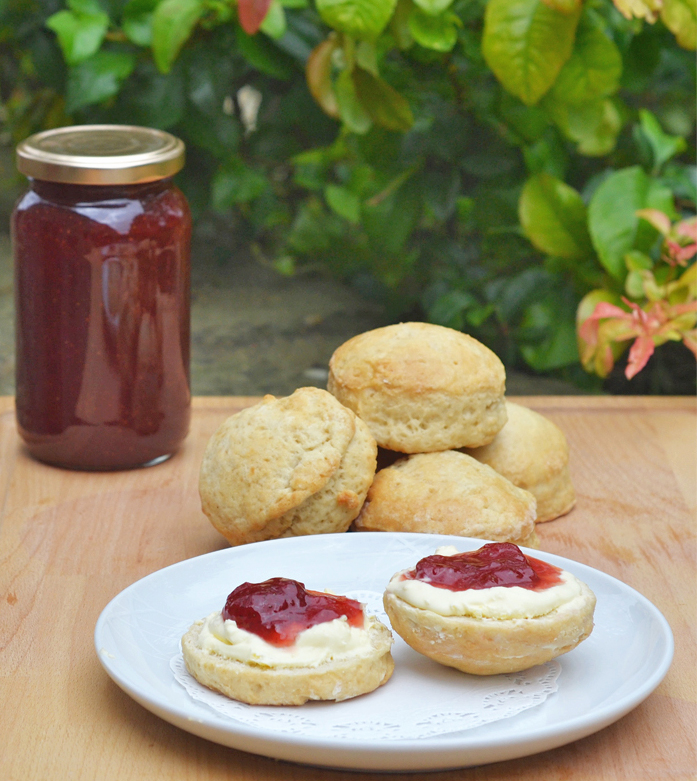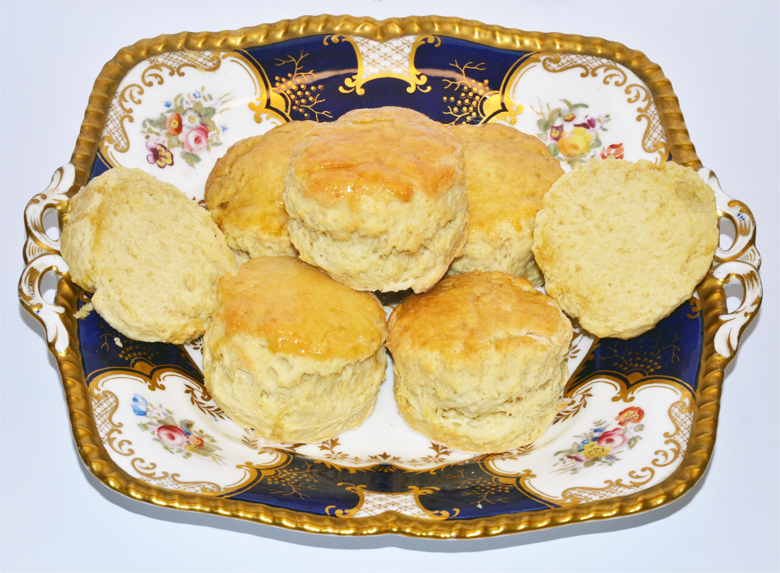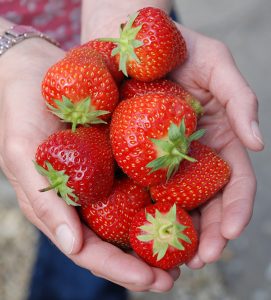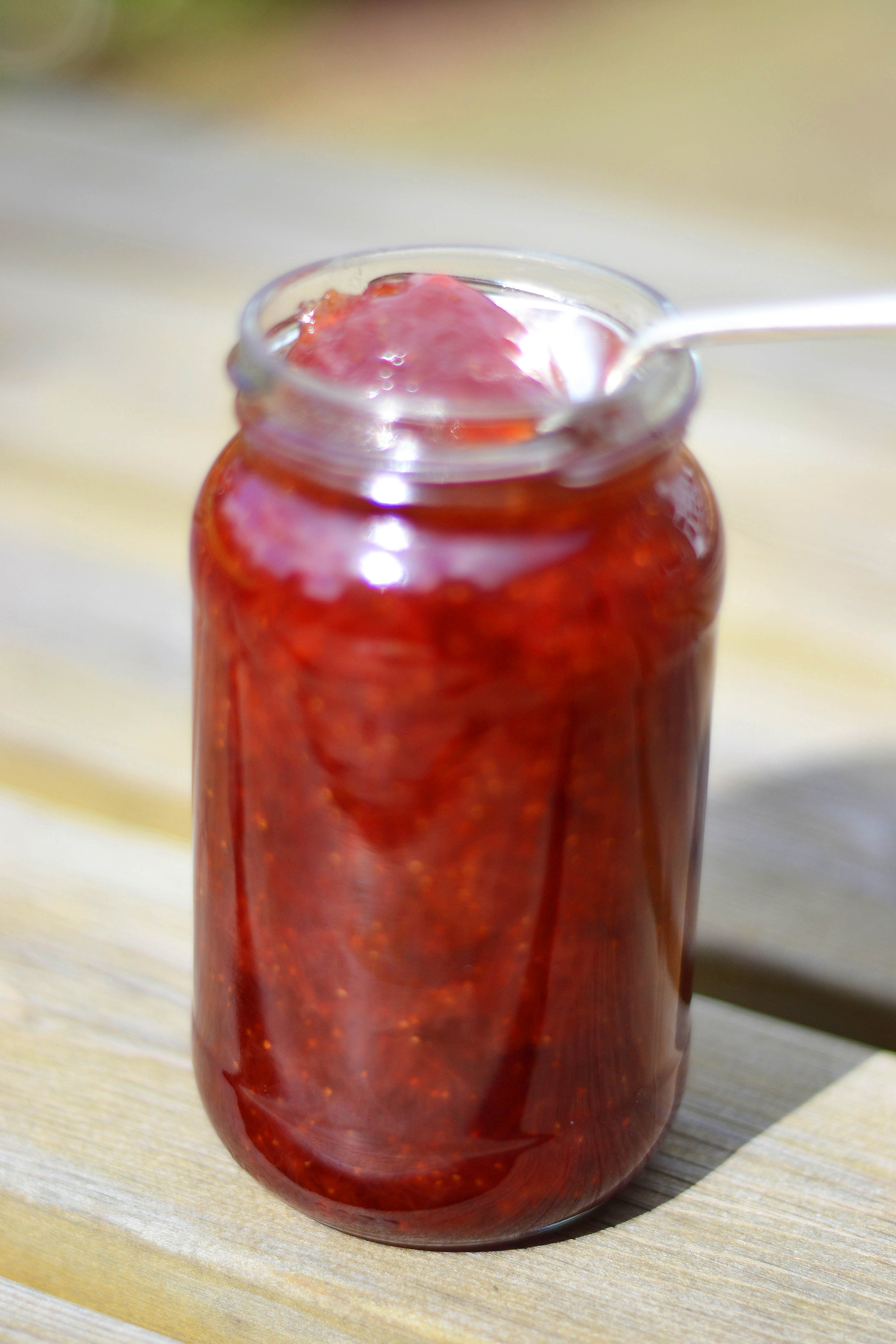 it is an opportunity to hold a charity cream tea and celebrate baked scones, jam and clotted cream.
it is an opportunity to hold a charity cream tea and celebrate baked scones, jam and clotted cream.Following the spread of railways and tourism during the 1850’s cream teas became popular in Devon and Cornwall. If you eat one in Devon, the cream then jam is spread on a freshly baked scone. In Cornwall the reverse happens and over the years, the order has been hotly debated. I adopt the Devon tradition and I believe great jam should be the star on top. I also have friends in Devon and would like to keep them.
Cream Tea Scones
As with the order of spreading, the word scone is pronounced differently depending on which part of the country you come from. The further North you live, it’s pronounced with a short vowel sounding like ‘skon’. Further South it sounds like ‘skone’. As a Londoner married to a Northerner it gets pronounced differently in our house.

Scone recipes made with flour and raising agents appeared in Scotland from the 1860’s. Tea rooms in Glasgow served them with butter and jam. Different fillings from dried fruit to cheese and herbs are used to enhance the plain mixture of ingredients in recipes, flour, fat, sugar and raising agents.
Lyle’s Golden Syrup Cookbook
Recently published, this cookbook has a fail safe recipe for scones. With a precise list of ingredients ( a bonus in a scone recipe ) it produces light, springy scones with a flavour sweetened by the addition of Tate and Lyle’s Golden Syrup. I’ve made the recipe a few times and the results are consistently good. The recipe is produced below with kind permission of Tate and Lyle.
Elegant Golden Scones
Makes 8 scones
Prep: 15 minutes
Cook: 15-18 minutes
30g Lyle’s Golden Syrup, plus 1 tablespoon for brushing
295g self-raising flour, plus extra for dusting and dipping
30g golden caster sugar
120ml whole milk
120ml single cream
jam or more Lyle’s Golden Syrup, and clotted or whipped cream, to serve
1. Preheat the oven to 180C/160C (fan)/ Gas Mark 4 and line a baking tray with silicone or baking parchment. Gently warm the golden syrup in a small pan, just until it loosens (do not boil).
2. Combine the flour and sugar in a bowl. Make a well in the centre then pour in the warm golden syrup, milk and cream. Quickly and lightly mix until just combined. (The mixture will be deliciously sticky).
3. Turn the mixture out onto a floured surface and gently pat the dough into a rectangular shape ( no need to roll it) with the well floured palms of your hands. You are looking for the dough to be about 2cm thick. The less you handle the dough the lighter the scones will be.
4. Dip a 6cm plain cutter into a small bowl of flour before stamping out the scones. Press the cutter down into the dough without twisting, or the scones will rise unevenly. Place the scones, set apart, on the prepared baking tray. Lightly re-form any trimmings to make more scones.
5. Bake on the middle shelf for 15-18 minutes, until well risen and golden. Remove from the oven and leave to cool on a wire rack. Heat 1 tablespoon of golden syrup in a small saucepan and use it to brush the tops of the scones. When cool, split and serve with cream and jam or golden syrup.
Strawberry Jam
 Traditionally Strawberry Jam is the number one choice for serving with a cream tea.
Traditionally Strawberry Jam is the number one choice for serving with a cream tea.
Makes about 2.25kg (5lb)
1.4kg 3lbs) strawberries, hulled
Juice of one lemon
300ml of pectin stock
1.4kg (3lb) granulated, cane sugar
1. Make the pectin stock by simmering 1kg of red currants, barely covered in water. Mash it thoroughly. Once the fruit is pulpy strain it into a bowl through a sieve lined with muslin. Measure the juice. Keep 300ml for the recipe and freeze any left over.
2. Put the fruit and the lemon juice into a large  preserving pan. Simmer until the fruit softens, about 10 minutes. Add the pectin stock and bring the pan back to a gentle simmer. Continue to cook for another twenty minutes. Warm the sugar in a low oven, 140C ( 120C Fan) /275F/Gas 1. Remove the sugar from the oven and place clean jars in the oven to warm for 10 minutes.
preserving pan. Simmer until the fruit softens, about 10 minutes. Add the pectin stock and bring the pan back to a gentle simmer. Continue to cook for another twenty minutes. Warm the sugar in a low oven, 140C ( 120C Fan) /275F/Gas 1. Remove the sugar from the oven and place clean jars in the oven to warm for 10 minutes.
3. Add the sugar to the preserving pan and stir until it has dissolved. Bring the jam quickly to a rolling boil and boil hard until setting point is reached. Test for a set after 8 minutes using the flake, cold plate or thermometer test. For a flake test, dip a large spoon into the pan and scoop out a spoonful. Lift the spoon above the pan and turn it horizontally. If the jam has reached setting point of 104.5℃ ( 220℉) it will drip then hang on the side of the spoon.
4.As soon as setting point is reached, remove the pan from the heat and leave it to stand for 10 minutes. Push any scum from the surface of the pan to the side and remove it with a metal spoon.
5. Gently stir the strawberry jam and pour it into warm, clean jars, up to the brim. Seal the jars immediately with new twist top lids. Leave the jars upright and undisturbed to set.
